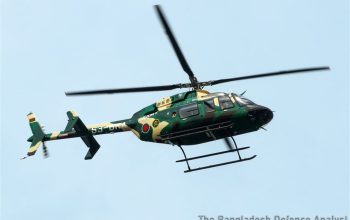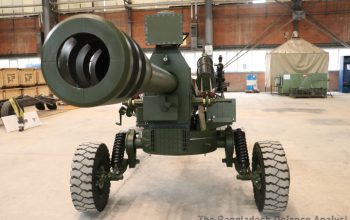MBDA UK has presented its portfolio of products to a high powered Bangladesh government delegation for inclusion in to the Bangladesh Navy and other armed services.
The European defence systems giant gave a briefing on the Sea Ceptor variant of the CAMM (Common Anti-Air Modular Missile) series is a family of surface-to-air missiles.
Bangladesh’s High Commissioner to the United Kingdom H.E. Saida Muna Tasneem and the Defence Attache of Bangladesh to the United Kingdom Brigadier General Md Mahbubur Rashid, SPP, ndu, psc visited MBDA Systems premises on 16 September to develop a cooperation stream.
MBDA claim that CAMM has a “wide target set”, including the capability to engage small naval vessels, which would give the missile a limited surface-to-surface role.
The CAMM has a range of <1–25 km with a maximum speed of Mach 3 (1,020 m/s) and is guided by two way data link and active RF seeker. It can be fitted on medium and larger warships to provide point defence and local area defence against sophisticated missile attacks and has the capability to defend against saturation attacks of supersonic anti-ship cruise missiles, aircraft and other high-performance targets.
It does this via multiple channels of fire, providing 360-degree simultaneous coverage and high degrees of manoeuvrability. MBDA state that CAMM has a “high rate of fire against multiple simultaneous targets”, providing capabilities comparable to the Aster 15 missile.
Design characteristics allow for low cost by modularity and minimising electromechanical complexity through implementing most functionality in software. Additionally, the command and control software reuses over 75% of that developed for the PAAMS system.
Even though the maximum range is stated as 25 km trials have shown a capability of up to 60 km. These ranges are significantly greater than any air defence systems in existence with the Bangladesh Armed Forces today.
CAMM weights 99 kilograms, is 3.2 m in length and 166 millimetres in diameter.
The Active RF seeker guidance means there is no need for complex and high-cost fire control/illumination radars.
A Soft Vertical Launch (SVL) system offers 360° degree coverage. This uses a gas generator to eject the missile from its canister, the benefits of which include increased range – by saving all the rocket motor’s energy to power the intercept – reduced minimum intercept range, reduced stress on launch platforms, reduced maintenance costs, more compact installations on ships and there being no need to manage the hot gas efflux on board, reduced launch signature, and on land the possibility of firing the missile from wooded or urban areas.
CAMM comes in its own launch canisters, or alternately can be quad-packed into existing vertical launching systems.
Currently the Royal Navy and British Army operate the CAMM. The Sea Ceptor variant is serving with the Royal Navy since May 2018 for equipping Type 23, Type 26 and Type 31 frigates.
The British Navy selected the Sky Sabre air defence variant to replace the venerable Rapier. It is speculated the CAMM (Sea Ceptor) will equip the Bangladesh Navy’s new generation frigates, which will be built indigenously.
Similarly the Bangladesh Army is seeking a medium range air defence system for induction. Already Army officials have visited Turkey to inspect the capabilities of the Hisar-O. The CAMM will ensure greater competition with Hisar-O and FM-3000 vertically-launched air defence missile systems.
Bangladesh Air Force is also seeking Britain’s assistance to smoothly acquire Eurofighter Typhoon multi-role capable fighter aircraft. It has already purchased five C-130Js from the United Kingdom recently.
Photo: MBDA Systems, UK.




